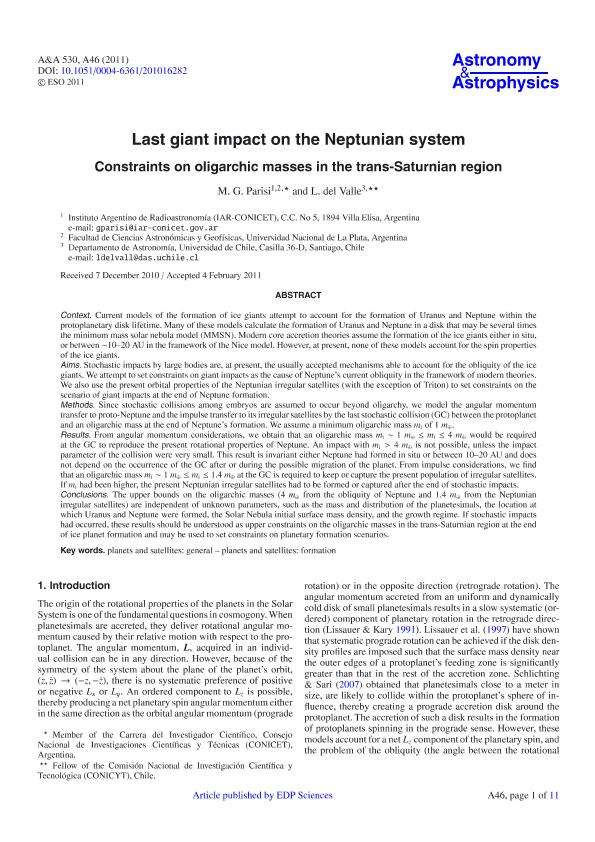Mostrar el registro sencillo del ítem
dc.contributor.author
Parisi, Mirta Gabriela

dc.contributor.author
Valle, Luciano del
dc.date.available
2016-03-04T19:58:32Z
dc.date.issued
2011-02
dc.identifier.citation
Parisi, Mirta Gabriela; Valle, Luciano del; Last giant impact on the Neptunian System : constraints on oligarchic masses in the trans-Saturnian region; EDP Sciences; Astronomy and Astrophysics; 530; A46; 2-2011; 1-11
dc.identifier.issn
0004-6361
dc.identifier.uri
http://hdl.handle.net/11336/4635
dc.description.abstract
Context. Current models of the formation of ice giants attempt to account for the formation of Uranus and Neptune within the protoplanetary disk lifetime. Many of these models calculate the formation of Uranus and Neptune in a disk that may be several times the minimum mass solar nebula model (MMSN). Modern core accretion theories assume the formation of the ice giants either in situ, or between ~10–20 AU in the framework of the Nice model. However, at present, none of these models account for the spin properties of the ice giants.
Aims. Stochastic impacts by large bodies are, at present, the usually accepted mechanisms able to account for the obliquity of the ice giants. We attempt to set constraints on giant impacts as the cause of Neptune’s current obliquity in the framework of modern theories. We also use the present orbital properties of the Neptunian irregular satellites (with the exception of Triton) to set constraints on the scenario of giant impacts at the end of Neptune formation.
Methods. Since stochastic collisions among embryos are assumed to occur beyond oligarchy, we model the angular momentum transfer to proto-Neptune and the impulse transfer to its irregular satellites by the last stochastic collision (GC) between the protoplanet and an oligarchic mass at the end of Neptune’s formation. We assume a minimum oligarchic mass mi of 1 m⊕.
Results. From angular momentum considerations, we obtain that an oligarchic mass mi ~ 1 m⊕ ≤ mi ≤ 4 m⊕ would be required at the GC to reproduce the present rotational properties of Neptune. An impact with mi > 4 m⊕ is not possible, unless the impact parameter of the collision were very small. This result is invariant either Neptune had formed in situ or between 10–20 AU and does not depend on the occurrence of the GC after or during the possible migration of the planet. From impulse considerations, we find that an oligarchic mass mi ~ 1 m⊕ ≤ mi ≤ 1.4 m⊕ at the GC is required to keep or capture the present population of irregular satellites. If mi had been higher, the present Neptunian irregular satellites had to be formed or captured after the end of stochastic impacts.
Conclusions. The upper bounds on the oligarchic masses (4 m⊕ from the obliquity of Neptune and 1.4 m⊕ from the Neptunian irregular satellites) are independent of unknown parameters, such as the mass and distribution of the planetesimals, the location at which Uranus and Neptune were formed, the Solar Nebula initial surface mass density, and the growth regime. If stochastic impacts had occurred, these results should be understood as upper constraints on the oligarchic masses in the trans-Saturnian region at the end of ice planet formation and may be used to set constraints on planetary formation scenarios.
dc.format
application/pdf
dc.language.iso
eng
dc.publisher
EDP Sciences

dc.rights
info:eu-repo/semantics/openAccess
dc.rights
Atribución-NoComercial-CompartirIgual 2.5 Argentina (CC BY-NC-SA 2.5 AR)
dc.rights.uri
https://creativecommons.org/licenses/by-nc-sa/2.5/ar/
dc.subject
Planets
dc.subject
Satellites
dc.subject
Satellite Formation
dc.subject
Planets Formation
dc.subject.classification
Astronomía

dc.subject.classification
Ciencias Físicas

dc.subject.classification
CIENCIAS NATURALES Y EXACTAS

dc.title
Last giant impact on the Neptunian System : constraints on oligarchic masses in the trans-Saturnian region
dc.type
info:eu-repo/semantics/article
dc.type
info:ar-repo/semantics/artículo
dc.type
info:eu-repo/semantics/publishedVersion
dc.date.updated
2016-03-30 10:35:44.97925-03
dc.journal.volume
530
dc.journal.number
A46
dc.journal.pagination
1-11
dc.journal.pais
Francia

dc.description.fil
Fil: Parisi, Mirta Gabriela. Consejo Nacional de Investigaciones Científicas y Técnicas. Centro Científico Tecnológico La Plata. Instituto Argentino de Radioastronomia (i); Argentina. Universidad Nacional de la Plata. Facultad de Ciencias Astronómicas y Geofísicas; Argentina
dc.description.fil
Fil: Valle, Luciano del. Universidad Austral de Chile; Chile
dc.journal.title
Astronomy and Astrophysics

dc.relation.alternativeid
info:eu-repo/semantics/altIdentifier/doi/http://dx.doi.org/10.1051/0004-6361/201016282
dc.relation.alternativeid
info:eu-repo/semantics/altIdentifier/url/http://www.aanda.org/articles/aa/abs/2011/06/aa16282-10/aa16282-10.html
Archivos asociados
